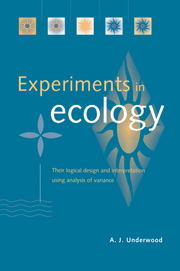Book contents
- Frontmatter
- Contents
- Acknowledgements
- 1 Introduction
- 2 A framework for investigating biological patterns and processes
- 3 Populations, frequency distributions and samples
- 4 Statistical tests of null hypotheses
- 5 Statistical tests on samples
- 6 Simple experiments comparing the means of two populations
- 7 Analysis of variance
- 8 More analysis of variance
- 9 Nested analyses of variance
- 10 Factorial experiments
- 11 Construction of any analysis from general principles
- 12 Some common and some particular experimental designs
- 13 Analyses involving relationships among variables
- 14 Conclusions: where to from here?
- References
- Author index
- Subject index
13 - Analyses involving relationships among variables
Published online by Cambridge University Press: 05 June 2012
- Frontmatter
- Contents
- Acknowledgements
- 1 Introduction
- 2 A framework for investigating biological patterns and processes
- 3 Populations, frequency distributions and samples
- 4 Statistical tests of null hypotheses
- 5 Statistical tests on samples
- 6 Simple experiments comparing the means of two populations
- 7 Analysis of variance
- 8 More analysis of variance
- 9 Nested analyses of variance
- 10 Factorial experiments
- 11 Construction of any analysis from general principles
- 12 Some common and some particular experimental designs
- 13 Analyses involving relationships among variables
- 14 Conclusions: where to from here?
- References
- Author index
- Subject index
Summary
So far, the concepts considered involve only one variable. In many experiments, it is extremely useful to investigate hypotheses about more than one variable and to test specified patterns of relationship between variables. Multivariate procedures for this are too large a topic to consider here. Analyses of regressions are, however, well worth introducing because of their widespread use and relationships to the topics considered earlier. This is a large and complex topic and the various issues will be considered only briefly here, in the context of tests of ecological hypotheses.
Introduction to linear regression
Regression, in its simplest form, is the analysis of a functional relationship where one variable (Y) is dependent on or linearly related to the magnitude of another (X). The analysis can be used to test hypotheses about the relationship and to estimate the parameters of the equation linking the magnitude of Y to that of X. The hypotheses predict the form of the relationship (linear in the simplest case) and the equation linking Y with X (i.e. the slope and/or intercept (or elevation) of the linear relationship).
The underlying regression equation in a linear case is a straight line passing through the means of the two variables (μy, μx). The equation predicts how far a given value of Y is from its mean, taking into account the magnitude of X.
Information
- Type
- Chapter
- Information
- Experiments in EcologyTheir Logical Design and Interpretation Using Analysis of Variance, pp. 419 - 477Publisher: Cambridge University PressPrint publication year: 1996
